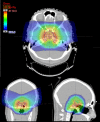Proton beam therapy: perspectives on the National Health Service England clinical service and research programme
- PMID: 31860337
- PMCID: PMC7066938
- DOI: 10.1259/bjr.20190873
Proton beam therapy: perspectives on the National Health Service England clinical service and research programme
Abstract
The UK has an important role in the evaluation of proton beam therapy (PBT) and takes its place on the world stage with the opening of the first National Health Service (NHS) PBT centre in Manchester in 2018, and the second in London coming in 2020. Systematic evaluation of the role of PBT is a key objective. By September 2019, 108 patients had started treatment, 60 paediatric, 19 teenagers and young adults and 29 adults. Obtaining robust outcome data is vital, if we are to understand the strengths and weaknesses of current treatment approaches. This is important in demonstrating when PBT will provide an advantage and when it will not, and in quantifying the magnitude of benefit.The UK also has an important part to play in translational PBT research, and building a research capability has always been the vision. We are perfectly placed to perform translational pre-clinical biological and physical experiments in the dedicated research room in Manchester. The nature of DNA damage from proton irradiation is considerably different from X-rays and this needs to be more fully explored. A better understanding is needed of the relative biological effectiveness (RBE) of protons, especially at the end of the Bragg peak, and of the effects on tumour and normal tissue of PBT combined with conventional chemotherapy, targeted drugs and immunomodulatory agents. These experiments can be enhanced by deterministic mathematical models of the molecular and cellular processes of DNA damage response. The fashion of ultra-high dose rate FLASH irradiation also needs to be explored.
Figures









References
-
- National Radiotherapy Advisory Group Report to Ministers Radiotherapy: developing a world class service for England. 2007. Available from: http://webarchive.nationalarchives.gov.uk/20130124035706/http://www.dh.g... [accessed 28/11/2019].
-
- Paganetti H. eds. Proton Therapy Physics, Second ed , vol. 13 ; 2019. ISBN-.

